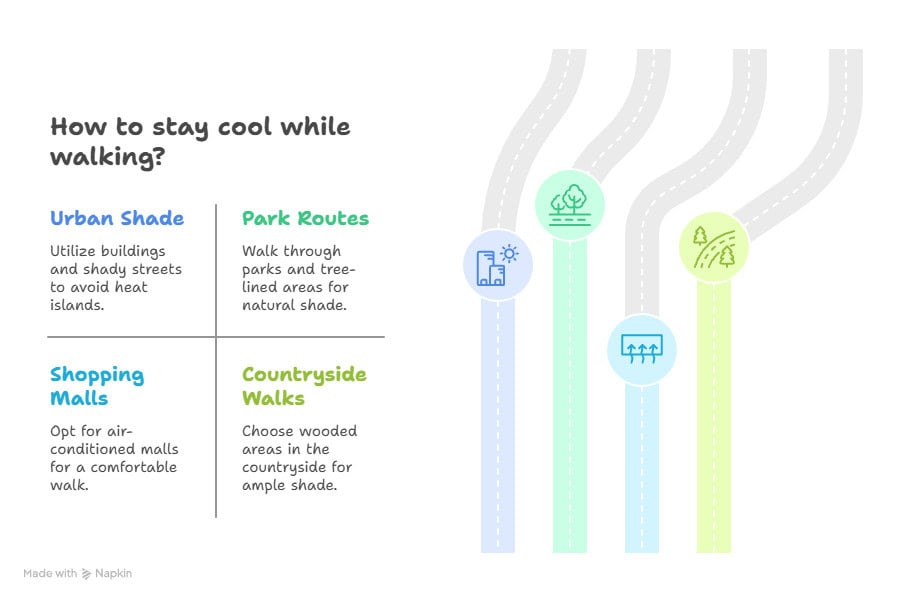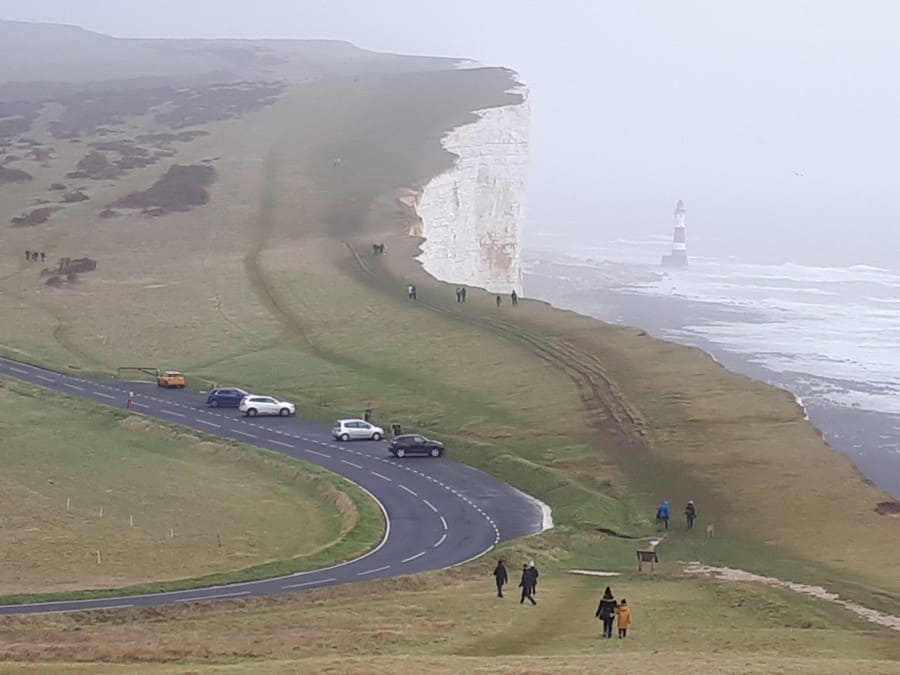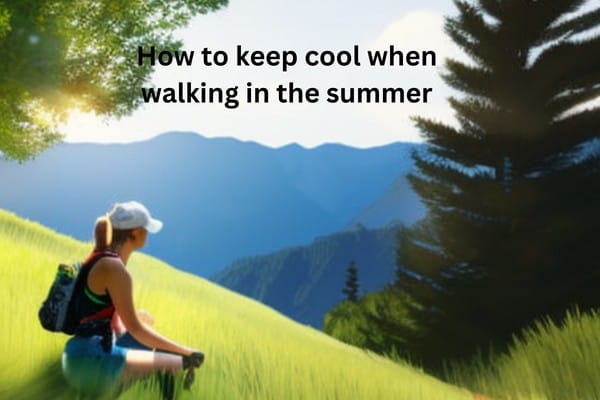Table of Contents
Some links on posts are affiliate links and will earn us a commission from qualifying purchases
The summer of 2025 is turning into a great summer, with some really hot days. Which is lovely if you are sitting by a pool or on the beach, but what happens if you are out putting in the miles walking and the sun is beating down on you?
To keep cool when walking in the summer you should:
- Keep hydrated
- Choosing Appropriate Clothing to Keep Cool When Walking
- Apply sun block
- Walk at the coolest times of the day
- Try to keep to shady areas
Keeping Hydrated: Your Body’s Natural Cooling System
Staying properly hydrated is perhaps the single most crucial step to keep cool when walking, especially in warm weather. When you exert yourself in the heat, your body’s primary cooling mechanism is sweating. This process, while effective, rapidly depletes your body’s water and essential electrolytes. Failing to replenish these can quickly lead to dehydration, significantly impacting your energy levels, focus, and overall health.
Physiology of Sweating & Dehydration:
Sweating is your body’s natural air conditioning system. As sweat evaporates from your skin, it carries heat away, cooling you down. However, this process consumes water and electrolytes.
If you don’t replace these, your blood volume can decrease, making your heart work harder, reducing oxygen delivery to muscles, and impairing your ability to regulate temperature – leading to heat exhaustion.
Why Hydration is Paramount:
- Sweat Production: Water is the main component of sweat, which cools your body as it evaporates from your skin.
- Body Function: Water makes up two-thirds of your body weight and is vital for nutrient transport, joint lubrication, and maintaining core body temperature.
- Preventing Heat-Related Illness: Adequate hydration prevents more serious conditions like heat exhaustion and heatstroke.
Your Hydration Strategy:
A good rule of thumb is to sip water regularly, even every 15-20 minutes, rather than guzzling large amounts. This allows your body to absorb fluids more effectively without overwhelming your system. Aim to carry at least 0.5-1 litre of water per hour of walking in hot conditions, adjusting based on humidity, intensity, and your personal sweat rate.
Post-Walk Rehydration: Continue drinking water once you’ve finished your walk to fully replenish lost fluids and aid recovery.
Pre-Hydrate: Don’t wait until you’re thirsty. I always make sure to drink a good pint of water at least an hour before setting off on a summer walk. This “pre-loading” gives your body a head start.
Hydrate During Your Walk: Aim to drink small amounts of water regularly – every 15-20 minutes, even if you don’t feel thirsty. It’s easy to get distracted by beautiful scenery, but waiting too long can lead to a dry mouth, fatigue, and even muscle cramps.
Carry Sufficient Water:
For most summer walks, I’ll carry one or two large water bottles in a comfortable rucksack. For longer hikes, a hydration bladder (like this popular Raniaco option on Amazon) can be incredibly convenient, allowing you to sip continuously without breaking your stride.
Consider Electrolytes:
If you’re walking for an extended period, sweating profusely, or find water isn’t quite cutting it (e.g., you’re drinking lots but still feel depleted and urinating frequently), electrolyte tablets can be a game-changer.
Electrolytes like sodium, potassium, and magnesium are vital minerals that help regulate nerve and muscle function, hydrate the body, and balance blood pH. When you sweat heavily, you lose these electrolytes.
Replenishing them with electrolyte tablets or sports drinks helps your body absorb water more efficiently and maintain critical bodily functions, preventing issues like heat cramps and severe fatigue.
Signs of dehydration:
Beyond a dry mouth and muscle cramps, be aware of other early signs of dehydration:
- Increased thirst
- Reduced urination (or dark yellow urine)
- Fatigue or dizziness
- Headache
- Irritability Promptly addressing these signs with fluids and rest is crucial to prevent more severe heat-related illnesses.

Choosing Appropriate Clothing to Keep Cool When Walking
Whenever possible, wear white or light coloured clothes for your summer walks. these will reflect the sun’s rays rather than attracting it. So when shopping for t-shirts bear this in mind – a white t-shirt can be used all year round, whereas a black t-shirt may have you regretting your shopping choices come July.
Traditional cotton, while soft, absorbs sweat and holds it against your skin, making you feel clammy and hot. Instead, look for synthetic performance fabrics like polyester, nylon, or blends designed for activewear.
These ‘wicking’ fabrics draw moisture away from your skin to the fabric’s outer surface, where it can evaporate quickly, providing a cooling effect. Merino wool is another excellent natural option, as it wicks moisture, resists odour, and surprisingly, helps regulate temperature in both warm and cool conditions.
Look for clothing with a UPF (Ultraviolet Protection Factor) rating. Unlike SPF (which applies to sunscreens and indicates protection against UVB rays), UPF measures the amount of UVA and UVB radiation that penetrates a fabric. A UPF of 30 blocks 97% of UV radiation, while UPF 50+ blocks 98% or more, offering significantly better protection than regular clothing or even high-factor sun cream alone, especially for prolonged exposure.
Choosing a long sleeved top such as this one, the Tacvasen lightweight long sleeve top with SPF 50 would be a great choice as it is also baggy which allows air to circulate more. It also comes in various colours – I’d suggest the white, either of the blues, or the grey.
Whilst getting your legs and arms exposed to the sun is tempting, if you can cover up completely with sun protection fabrics that also wick away moisture as you move, then you will benefit greatly.
A real must on a truly hot day is a hat, to keep the sun off your head. And if you are like me and appear to have less hair up top each year, then it’s so easy to burn the top of your head before you know it.
Beyond a general hat, consider a wide-brimmed hat (like a bucket hat or hiking specific hat) that offers 360-degree shade for your face, ears, and neck. Some even come with a detachable neck flap (often called a ‘legionnaire style’ hat) for maximum coverage. The ‘old loose cotton hat soaked in cold water’ trick works wonders – the evaporative cooling directly on your head is incredibly effective.
If it’s really old you may consider cutting a few holes in it to release heat. I’d recommend removing whilst in shaded woods to give your head chance to breathe without the sun baking you from top down.
Specialized cooling towels are also fantastic. Made from hyper-evaporative materials, you simply wet them, wring them out, and snap them, and they become significantly cooler than ambient air, providing instant relief around your neck or head. They’re a lightweight and highly effective tool to add to your hot weather kit.
Bandanas are also great in the heat for keeping you cool. When you pass a stream or lake you can dip the bandana into the water and then put it round your neck or head. That will help you keep cool whilst you walk. You could even wet yours before you head off to ensure you get a good start to your walk in the heat.
Your feet generate a lot of heat. While walking sandals are an option for suitable terrain, ensure they offer adequate support. For more rugged walks, look for trail shoes with highly breathable mesh uppers that allow air circulation and heat escape, coupled with moisture-wicking socks (avoid cotton here too!) to prevent blisters and manage sweat.
Of course, don’t forget sunglasses to protect your eyes from the glaring sunshine. And have you considered ditching the shoes for walking sandals – these are much more common these days and manufacturers have realised their importance.
Applying sun block
For effective protection, look for a broad-spectrum sunscreen (protecting against both UVA and UVB rays) with an SPF of at least 30, and ideally 50+, especially on high UV index days or for prolonged exposure. Apply it generously to all exposed skin about 20-30 minutes before you head out, allowing it to properly absorb.
Even ‘water-resistant’ sunscreens will eventually lose their efficacy with heavy sweating. Reapply every two hours, or more frequently if you’re sweating heavily or wiping your face often. Don’t forget often-missed spots like the tops of your ears, neck, hands, and the backs of your knees.
While spray sunscreens offer convenience for reapplication on the go, ensure you apply enough. It’s often harder to gauge coverage with a spray compared to a lotion. Many experts still recommend a lotion for the initial, thorough application, reserving the spray for quick top-ups.
Walk at the cooler times of the day
This may seem obvious, but if you are used to rising late and heading off out for a walk just before or after lunch, then you will find that the sun has risen to it’s highest point and is beating down it’s rays on you.
Ideally you should set your alarm and get up and out early – there’s nothing wrong with setting out at 6 or 7 am, as that will be when the day is at it’s coolest. Of course, not everyone wants to get up that early on the weekend – hands up from me – especially after a long week in the office of early mornings and late nights.
Walking during the cooler parts of the day drastically reduces the heat stress on your body. Your body expends less energy trying to regulate its temperature, meaning you’ll feel less fatigued, maintain a better pace, and significantly reduce your risk of heat-related illnesses.
Generally speaking it’s at it’s hottest between 12:00 and 15:00, so if you are out on an all day walk then plan to be somewhere shady or by a lake at this point. It will be a little cooler than out in the open, and you can also keep cool with the water by splashing it over you or dipping your bandana or sunhat in.
If an all-day walk is planned, schedule your longest break during these peak heat hours. Seek out locations where you can sit in deep shade, near water sources, or even pop into an air-conditioned cafe or visitor center to allow your core body temperature to fully drop. This strategic pause isn’t ‘giving up’; it’s smart heat management.
If that is you too, you may want to consider delaying your walk till the evening hours. At this time the temperature starts to drop and walking becomes a little easier.

Keep an eye on the weather forecast. Whilst the forecasters don’t always get it 100% spot on, generally speaking weather men and ladies are pretty good – and good enough to see what the temperature is going to be like the following day.
And that’s another tip – plan your walk the night before. If you know it’s going to be a scorcher and your best bet is going to be an early morning walk, then staying up late to watch Match of the Day or the latest horror film isn’t going to be the best preparation. Head off to bed at a reasonable time, get your walking gear ready and ideally pack a rucksack with your hat, sun block and sunglasses. That way you won’t be eating up valuable time and the sun rising more and more every minute whilst you faff around looking for stuff. Don’t forget to stick a bottle of water or two into the fridge before bed.
Beyond checking the temperature, also look at the ‘feels like’ temperature (which accounts for humidity) and the UV index. A high UV index means the sun’s rays are more potent, even if the air temperature isn’t scorching. Use weather apps that provide hourly forecasts to pinpoint the absolute coolest windows for your activity. Consider starting your walk at sunrise to truly beat the heat and enjoy the tranquility.
One thing I really want to mention is for those of you that walk with dogs. Please, please, please put their health and safety first and set off early! Yes you may want a lay in, but your dog cannot get rid of body heat as easily as us humans, so be a considerate owner and walk them before the sun gets too hot.
I lost count of the number of times I saw poor dogs slowly walking along the streets just before lunchtime last summer. Clearly they were in distress, too hot to move quickly, and yet the owners seemed oblivious. Don’t be a selfish owner – get up early, get out and back before it’s too hot, and make sure your dog has plenty of water before, during and after a walk.
Try to keep to shady areas
It’s not always possible to stay in the shade when walking any distance. However, there are things you can do that will help.
In urban environments, concrete and asphalt absorb and radiate heat, creating an ‘urban heat island’ effect. Prioritize walking on the shady side of streets and use buildings for cover. If possible, opt for routes through parks, along tree-lined boulevards, or beside rivers, which can offer slightly lower temperatures and more natural shade than open city streets.
If you are combining your walk with shopping, then an air conditioned shopping mall gives a much better walking experience. I am a big advocate of shopping locally and keeping local businesses going by spending my money with them, but a mall can give a much better walking experience in heat.
Ideally you take a trip to the countryside. Grass will absorb heat, although if you are in an open field you may struggle to reap much of a benefit. Seek out walks that have large areas of wooded stretches with ample shade to walk in. The trees will help keep the suns rays out.

Trees provide dense canopy shade, blocking direct sunlight. Additionally, forests can have a slightly cooler microclimate due to evapotranspiration (moisture released by plants).
Before you set out, use online mapping tools (like Google Maps satellite view or dedicated hiking apps) to scout out routes that offer natural shade from trees or provide access to water features. Knowing where you can find relief can make a big difference on a hot day.
Along coastlines or near large bodies of water (lakes, wide rivers), the ‘sea breeze’ or ‘lake effect’ can significantly lower the perceived temperature. This natural air movement helps dissipate heat and aids in evaporative cooling from your skin. Even a small stream can provide an opportunity to cool down by splashing water on your pulse points (wrists, neck) or soaking a bandana.
A walk along the coast is a great option in the sun. Not only will you benefit from sea breezes keeping the temperature a degree or two lower, but you stand a good chance of meeting an ice cream man (sorry – I couldn’t resist). The only downside is that you could find certain seaside towns and destinations extremely busy. I love to go to Beachy Head and walk along to Birling Gap. In winter this can be quite desolate – in summer it’s a whole different story.
If you are at the coast, then a trip down the beach to the sea will help – you can take off your shoes and socks and have a quick paddle, and also splash yourself down with the cool water of the sea. Cooling down your feet will go a long way to lowering your skin temperature quickly.

Recognizing and Responding to Heat-Related Illnesses
While these tips will greatly help you keep cool when walking, it’s essential to be aware of the signs of heat-related illnesses and know how to respond. Early recognition can prevent a serious medical emergency.
1. Heat Cramps:
- Symptoms: Muscle pains or spasms, often in the abdomen, arms, or legs.
- Action: Stop activity, move to a cool place, sip water or an electrolyte drink, and gently stretch or massage the cramped muscle.
2. Heat Exhaustion:
- Symptoms: Heavy sweating, cold/pale/clammy skin, fast weak pulse, nausea or vomiting, muscle cramps, tiredness, weakness, dizziness, headache, fainting.
- Action: This requires immediate attention.
- Move to a cool place (shade, air-conditioned room).
- Lie down and loosen clothing.
- Apply cool, wet cloths to the body (especially neck, armpits, groin).
- Sip water slowly.
- If symptoms worsen or last longer than an hour, or if the person vomits, seek medical help immediately.
3. Heatstroke (Medical Emergency):
- Symptoms: High body temperature (103°F/40°C or higher), hot/red/dry or damp skin, rapid strong pulse, throbbing headache, dizziness, nausea, confusion, unconsciousness. This is a medical emergency and can be fatal.
- Action:
- Call 999 (or your local emergency number) immediately.
- Move the person to a cooler place.
- Attempt to cool the person rapidly (e.g., cool bath or shower, spray with garden hose, apply cold wet cloths or ice packs to head, neck, armpits, and groin).
- Do NOT give the person anything to drink.
Always err on the side of caution. If you suspect heatstroke, call for emergency medical help immediately!!!
Conclusion – How to keep cool when walking in the summer
Successfully navigating a summer walk in the heat isn’t just about enduring it; it’s about being prepared, proactive, and attuned to your body’s signals. By implementing these strategies – smart hydration, appropriate clothing, vigilant sun protection, and strategic timing – you transform a potentially challenging experience into an enjoyable and safe one.
Remember, listening to your body and prioritizing safety is paramount. If you or a walking companion ever feel unwell due to heat, don’t hesitate to take a break, cool down, and if necessary, seek medical advice. Staying cool ensures you can continue to enjoy the benefits of walking all year round.
More reading
Walking in thunderstorms – how to protect yourself
Recent Posts
Walking in woods and forests can be magical, and has such a great calming influence on your welfare.
Hike Smarter: Hiking Apps to Plan Your Next Adventure for 2025
Planning a great hike means having the right tools. The best apps combine maps, route details, weather forecasts, and safety features to make your trip easier and safer. They help you find trails,...





